Although the components for Gale Force Nine's Star Trek: Ascendancy are generally pretty exceptional (and the expansion components are also quite high quality), I did have one major disappointment with the package: the game does not include plastic figures to represent the various faction's starbases. Instead, the game uses cardboard tokens to represent starbases. These are functionally fine, but they just don't have the presence on the board to match their strategic importance within the actual game, and it's easy for them to kind of disappear into the background of the game's map. The individual cardboard tokens don't even have art specific to each faction; all five factions have pictures of Federation starbases on the top.
The manufacturer was apparently aware of this, and, in addition to selling "expansions" containing additional ships and control nodes for each faction, they also sell a set of three plastic starbase figures for each faction.
All factions use carboard tokens for starbases, all of which have pictures of Starfleet starbases.
Since I really like the Ascendancy board game, I wanted to support the manufacturer and designers. I had already purchased all three of the game's expansions (the Cardassian faction, Ferengi faction, and Borg: Assimilation expansion), and I'll be playing and reviewing them soon. I also went ahead and bought the starbases. GF9's storefront wants $12 USD for each set of a faction's three starbase figures. That's a pretty steep price for components for a game that already costs $100 without any expansions. $12 times five factions comes to $60 (almost two-thirds the cost of the core game!). The core game's components are all pretty nice, as are the components for the Borg expansion, and the pictures of the bases looked pretty nice (even though they are unpainted). So I went ahead and made a purchase.
I was excited to have the new toys to play with -- I always like getting new games and toys. But when they showed up, a lot of that excitement was dashed. The product that had been delivered was substantially sub-par.
These are definitely not ready to be played with out-of-the-box...
Defects and poor quality
The Ferengi and Klingon bases were attached to plastic frames and had to be torn off, and the remains of the frames had to be cut off of the starbase figures in order for the figures to fit into their bases and stand on their own. One of the Ferengi figures snapped and broke while I was removing it from its plastic frame. I had to super-glue it back together... [More]
0c252a06-3e87-4d43-b75e-bc67b2ad3788|1|5.0
Tags:Star Trek, Star Trek Ascendancy, Gale Force Nine, board game, strategy, 4x, Federation, Romulan, Klingon, Cardassian, Ferengi, starbase, miniature, glue
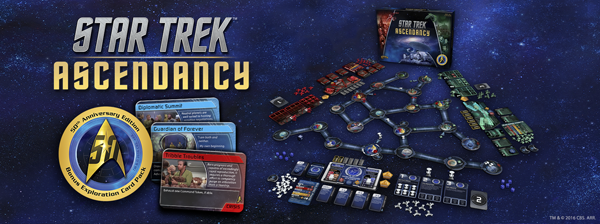
As I had mentioned in my Star Trek: Fleet Captains review, good Star Trek games are few and far between. Perhaps my favorite Trek game of all time is the Windows '98 4-x strategy game Birth of the Federation. BotF, developed my Microprose, was basically a Trek reskin of Master of Orion II. It was buggy, had cheating A.I., suffered from a major memory leak that slowed the game to a crawl after about 100 turns of play, and it didn't include any Original Series ships or technologies. But it did manage to faithfully capture Star Trek's spirit of exploration and discovery by being a game about exploring and colonizing a galaxy.
It wasn't a stripped-down startship combat simulator (Starfleet Command), or a cookie-cutter first-person shooter (Elite Force), or a lazy StarCraft clone (Armada), or an out-of-place dogfighter (Invasion), or a derivative WoW clone (Star Trek: Online). None of those games is terrible. I've played them all, and actually have some rather fond memories with most of them. But none of these games really meshed perfectly with the Star Trek license, and none of them really scratched my Star Trek gaming itch the way that Birth of the Federation did. Apparently, some designers at Gale Force Nine also like Birth of the Federation, because their new board game, Star Trek: Ascendancy, almost feels like a board game version of that classic Trek PC game.
Ascendancy is the first proper 4-x board game using the Star Trek license that I've seen. It certainly blows Fleet Captains out of the water. While Fleet Captains included some token exploration and territory-expansion mechanics as a supplement to the ship-to-ship combat that was the core of the game, Ascendancy is a game that is actually about exploring a procedurally-generated map, colonizing planets, and developing their resources. You can win by conquering other players' home worlds, or by developing your culture up to a specific level.
The final frontier is always in flux
The board of Star Trek: Ascendancy utilizes an interesting and novel modular board. Disk tiles represent planets, systems, and anomalies, each of which is connected by star lanes of varying distances. New systems and star lanes are drawn from a deck as the players explore, and so the board is constantly expanding as you play. It's nothing earth-shatteringly new, but it does have one neat gimmick that I haven't seen in other similar games.
The map will grow and change as the game progresses.
In addition to the board dynamically growing as the game progresses, systems are considered to be "floating" until they become locked in place by being connected to two or more systems via a star lane. This means that leaf systems can be freely rotated around to make room for other tiles to be placed in the play area. I believe this is intended to model the 3-dimensional nature of space. In a more practical sense, it means that the galaxy [map] can (and will) change its shape occasionally, leaving the true distances between locations ambiguous until everything gets locked down. [More]
7b9b6ce0-3004-4c0d-a534-30ff155f91cb|1|1.0
Tags:Star Trek, Star Trek Ascendancy, Gale Force Nine, board game, strategy, 4x, dice, Federation, Romulan, Klingon, exploration, phenomenon, trade, colonization, war, star lane, warp, warp drive, Aaron Dill, John Kovaleski, Sean Sweigart, Star Trek: Birth of the Federation
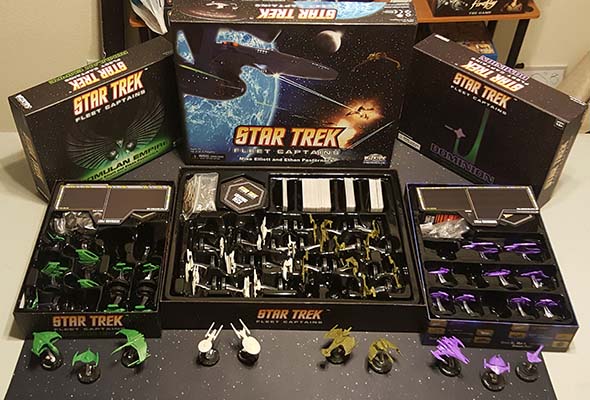
Star Trek: Fleet Captains has expansions for the Romulan Empire and Dominion.
Even though it is a kind of mediocre game, my friends and I liked Star Trek: Fleet Captains enough that we were excited to try out the game's expansions. There's a nice, episodic feel to the game that does do a pretty good job of capturing some of the feel of the source material. Fleet Captains has two expansions, which each offer a new playable faction: the Romulan Empire and the Dominion. Both expansions revolve around the same two core mechanics (espionage and saboteurs), but each has its own unique methods and techniques for how they utilize those mechanics. Since both expansions have similar features, I'm going to review both expansions together.
The Romulan Empire connives its way to victory
The Romulans are my favorite race in Star Trek I like Romulan makeup. I like their uniforms. I like their ship designs (especially the warbirds). I like their cunning. And I like the depictions of the Romulans in every era of Star Trek, except for Star Trek: Nemesis and Star Trek: Enterprise, which both managed to ruin a good thing. So opening the Fleet Captains box to find no Romulan ships was - of course - disappointing, and the very first thought that popped into my mind (after "Ooh, plastic space ships!") was "I should check if there's a Romulan expansion to this game". Sadly, it was sold out on Amazon, and eBay sellers wanted upwards of $150 for copies. I didn't want a Romulan expansion that badly... But my girlfriend, being awesome as she is, eventually saw the expansion come back in stock on Amazon and immediately ordered a copy for me to surprise me. So as I was getting ready to organize some game sessions to play the Dominion expansion and resigning myself to the idea that I'd never play the Romulans, a shiny, shrink-wrapped copy of the expansion literally showed up at my door step. She's a keeper!
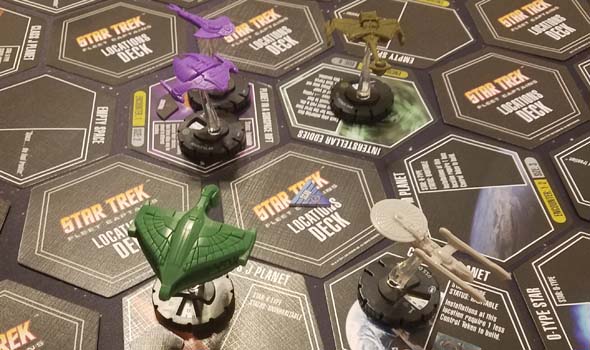
I don't like the monochrome ships, but at least the Romulan ships are the same color as in the show.
The green plastic of the Romulan ship miniatures fits well with the color schemes of Romulan ships in the shows, and the miniatures don't look as dull as the unpainted miniatures in the base game. The only Romulan ships that wouldn't be green would be Original Series Birds of Prey (or borrowed Klingon battle cruisers), which aren't included in the expansion's ship roster anyway. Instead, they included three Birds of Prey from Enterprise. That's a shame to me, since I really like the Original Series Bird of Prey's design - not as much as I like the TNG Warbird design, but the TOS Bird of Prey is up there in my list of favorite ships. I really would have liked to have seen one of the Enterprise Birds of Prey replaced with a TOS Bird of Prey in the roster, and maybe even a borrowed Klingon Battle Cruiser, but no such luck. Ah well... [More]
62e7d974-a66f-4dc9-8815-e176dc78759e|2|3.0
Tags:Star Trek: Fleet Captains: Romulan Empire, Star Trek: Fleet Captains: Dominion, Star Trek, Star Trek: Fleet Captains, board game, expansion, WizKids, Romulan, Dominion, Cardassian, Vorta, Jem Hadar, changling, shapeshifter, espionage, cloak, sabotage, defect, manufacturer defect, customer support, Star Trek: Enterprise, Mike Elliot, Ethan Pasternack
Almost a decade ago, my love of board-gaming was kick-started by a single game. That game was Fantasy Flight's Battlestar Galactica board game. For a period of a couple years, my friends and I were playing that game once or twice almost every month. Even after we started branching out to other games, BSG would regularly grace our tables.
The Battlestar Galactica board game kick-started my tabletop hobby.
Unfortunately, as time went on, members of the regular group(s) that I played with got new jobs, moved, started families, and it became harder and harder to get a large enough group together to play a 4 or 5-hour long board game. Eventually, BSG (along with all my other games) started collecting dust on a shelf.
It wasn't until a few years ago that I finally got back into having semi-regular board game sessions, thanks primarily to my girlfriend taking an interest in X-Wing. Most of our board gaming in the past years has been dominated by either quick group games (such as Dominion, One Night Ultimate Werewolf, Resistance, or Cards Against Humanity), or smaller, two-player games (like the aforementioned X-Wing). No one game has dominated in quite the same way that BSG did. I'd like to play it again, and maybe someday I'll even put up a review of it, but we haven't dusted the ol' game off because we rarely have the time for it. When we do have a whole evening cleared for an epic game, we try to play other games that we haven't already played the hell out of.
Well, clearly, I wasn't the only one who loved Battlestar Galactica, but wished it didn't take so bloody long to play, because Evan Derrick's 2011 game Dark Moon is basically a reskin of Battlestar Galactica that only takes an hour and a half to play. Dark Moon accomplishes this by reducing a lot of the mechanical complexity and by making progress in the game a lot more straight-forward. Virtually every mechanic or interaction in Dark Moon is a direct analog to a mechanic or interaction in BSG.
The shape-shifting space monster among us
The core conceit of Dark Moon (and Battlestar Galactica) is that the game is a semi-cooperative game in which most of the players are working together to try to prevent their moon-based mining station from falling apart around them. However, one or more of the players is secretly a shape-shifting alien (an "infected") who is trying to sabotage the station and kill all humans. Players take turns performing a single action to try to stabilize the deteriorating mining station. However, the most efficient action is to "issue an order" to another player to allow that player to take multiple actions. The catch is that the player you give the order to may secretly be a saboteur, so you have to be careful about only giving orders to other players who you trust.
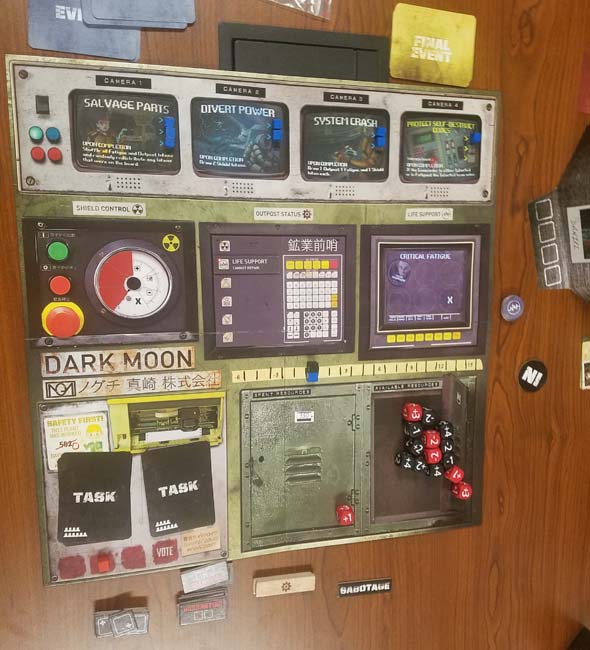
Players cooperate to complete a series of events, but some players are secretly traitors.
At the end of each player's turn, the entire group participates in a group task. Each task card has a pass or fail condition. Passing may result in positive effects for the uninfected players, and failing may result in harmful effects. These group tasks ensure that every player gets to participate in virtually every turn, so you're never sitting around twiddling your thumbs waiting for other players to do things. Even if you weren't participating in the turn, it would still behoove you to pay close attention to what's going on, if for nothing else than to look for any tells or indications that the current player may be an Infected... [More]
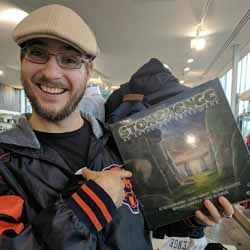
Souvenir board game!!!
During a holiday in Europe, I procured a few souvenir board games to add to my collection.
I didn't have room in my luggage for the larger Stonehenge Anthology Game or the Ring of Stones game. So instead of buying them in the Stonehenge gift shop, I ordered them online and had them shipped to my house. They were both waiting for me when I returned home from the trip! The Ring of Stones game was purchased directly from the English Heritage online shop's Stonehenge gifts section. The Anthology game had to come from Amazon because it isn't available from the English Heritage online shop, but I got a really good deal on it!
There was also some Stonehenge Monopoly and playing cards, but I'm not into those sorts of novelty variations that I can get anywhere. It was the unique games that caught my eye.
The third game that I brought back from Europe is a medieval Viking game called "Hnefatafl". I had seen it in the Viking Ship Museum gift shop when I was there last November, but I didn't buy it at the time because I wasn't sure if its rules were written in English or Danish. I didn't want to buy a game that I'd never be able to play because I couldn't read the rules. So when I saw the same game in the British Museum's gift shop this summer, I decided to go ahead and get it.
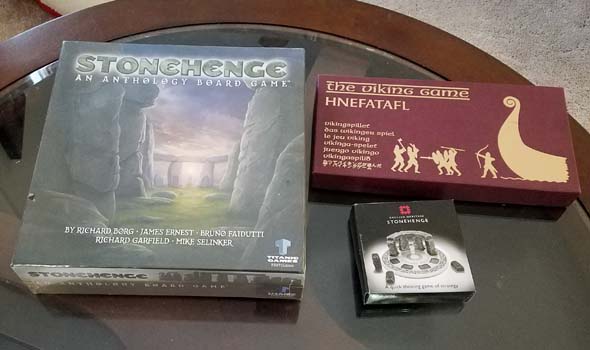
My European souvenir board games include 2 Stonehenge-themed games and a traditional Viking game.
I already talked about the Stonehenge Ring of Stones game and the anthology game, so today I will talk about the game that I should have bought in my first trip to Denmark: Hnefatafl (The Viking Game).
The Viking Game: Hnefatafl
While the previous Stonehenge-themed games are modern inventions, the Viking Game Hnefatafl (ne-fe-ta-fel) is a classic Norse game from the early middle ages. It was invented around 400 CE. It has some similarities to chess, but predates that game by at least 500 years. Besides, chess traces its lineage to India, so it's unlikely that Hnefatafl is a predecessor of chess.
Basically, Hnefatafl is an asymmetrical, chess-like game in which the single king and his defenders is ambushed and surrounded by the other player's pieces. All pieces move vertically or horizontally across the board (like rooks in chess), and pieces are killed/captured by flanking them on two opposing sides. The objective for the king's player is for the king to escape to any corner of the board; while the attacking player's objective is to defeat the king by surrounding it on all four orthogonally-adjacent spaces.
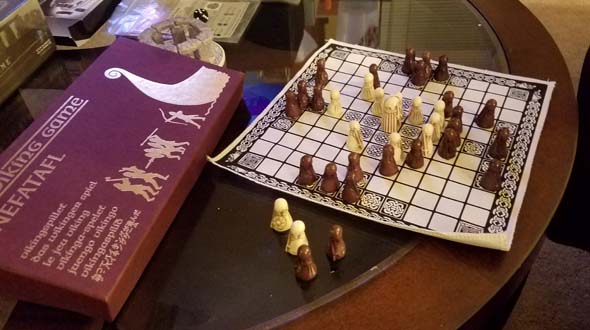
Hnefatafl is an asymmetrical, chess-like game in which a single king tries to escape from an ambush of attackers.
One of the things that makes the game a bit challenging (compared to chess) is that attacks can come from any direction, and every piece can hypothetically move the entire distance of the board... [More]
d734d0b3-ea54-41d2-9ce4-cdcc203a6765|0|.0
Tags:Hnefatafl, Viking Chess, the Viking game, Viking, chess, board game, king, pawn, rook, Denmark, Viking Ship Museum, Europe, ambush
|

| 12 | | | | | | | 60 | | 11 | | | | | | | 55 | | 10 | | | | | | | 50 | | 09 | | | | | | | 45 | | 08 | | | | | | | 40 | | 07 | | | | | | | 35 | | 06 | | | | | | | 30 | | 05 | | | | | | | 25 | | 04 | | | | | | | 20 | | 03 | | | | | | | 15 | | 02 | | | | | | | 10 | | 01 | | | | | | | 05 |
|